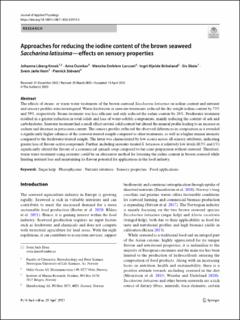Approaches for reducing the iodine content of the brown seaweed Saccharina latissima—effects on sensory properties
Krook, Johanna Mathilda Liberg; Duinker, Arne; Larssen, Wenche Merete Emblem; Birkeland, Ingri Mjelde; Skeie, Siv Borghild; Horn, Svein Jarle; Stevant, Pierrick Francois Denis
Peer reviewed, Journal article
Published version
Permanent lenke
https://hdl.handle.net/11250/3098324Utgivelsesdato
2023Metadata
Vis full innførselSamlinger
Sammendrag
The effects of steam- or warm water treatments of the brown seaweed Saccharina latissima on iodine content and nutrient and sensory profiles were investigated. Warm freshwater or seawater treatments reduced the dry weight iodine content by 73% and 59%, respectively. Steam treatment was less efficient and only reduced the iodine content by 26%. Freshwater treatment resulted in a greater reduction in total solids and loss of water-soluble components, mainly reducing the content of ash and carbohydrates. Seawater treatment had a small effect on total solid content but altered the mineral profile leading to an increase in sodium and decrease in potassium content. The sensory profiles reflected the observed differences in composition as it revealed a significantly higher saltiness of the seawater-treated sample compared to other treatments, as well as a higher umami intensity compared to the freshwater-treated sample. The latter was characterized by low scores across all sensory attributes, indicating greater loss of flavour-active compounds. Further, including seawater-treated S. latissima at relatively low levels (0.5% and 1%) significantly altered the flavour of a commercial spinach soup compared to the same preparation without seaweed. Therefore, warm water treatment using seawater could be an alternative method for lowering the iodine content in brown seaweed while limiting nutrient loss and maintaining its flavour potential for applications in the food industry.
